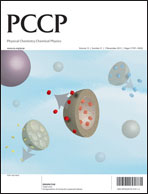The Ehrenfest force topology: a physically intuitive approach for analyzing chemical interactions†
Abstract
Modified ANO-RCC basis sets are used to determine twelve molecular graphs of the Ehrenfest force for H2, CH4, CH2O, CH3NO, C2H2, C2H4, C3H3NO, N4H4, H2O, (H2O)2, (H2O)4 and (H2O)6. The molecular graphs include all types of topological critical points and a mix of bonding types is chosen to include sigma-, π- and hydrogen-bonding. We then compare a wide range of point properties: charge density, trace of the Hessian, eigenvalues, ellipticity, stiffness, total local energy and the eigenvectors are calculated at the bond critical points (BCPs) and compared for the Ehrenfest, QTAIM and stress tensor schemes. QTAIM is found to be the only partitioning scheme that can differentiate between shared- and closed-shell chemical bond types. Only the results from the Ehrenfest force partitioning, however, are demonstrated to be physically intuitive. This is demonstrated for the water molecule, the water-dimer and the water clusters (H2O)4 and (H2O)6. In particular, both the stiffness and the trace of the Hessians of the appropriate quantities of the sigma-bond BCPs for the water clusters are found to depend on the quantum topology dimension of the molecular graph. The behavior of all the stress tensor point properties is found to be erratic. This is explained by the ambiguity in the theoretical definition of the stress tensor. As a complementary approach the Ehrenfest force provides a new indicator of the mixed chemical character of the hydrogen-bond BCP, which arises from the collinear donor sigma-bond donating a degree of covalent character to the hydrogen-bond. This indicator takes the form of the relative orientation of the shallowest direction of the Ehrenfest potential of the hydrogen-bond BCPs and the corresponding direction for the collinear sigma-bond BCP.


 Please wait while we load your content...
Please wait while we load your content...